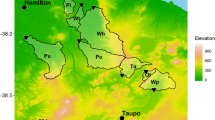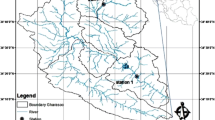Abstract
Chemical monitoring data on two rivers draining small-scale and medium-scale watersheds were collected and analyzed. It was shown that the variability in stream water chemistry is explained mostly by two natural processes. The first process is the change in dominant water flow path in soil during the year and the second process is the change in water table depth. These changes are reflected in dissolved organic carbon (DOC) to base cations (BC) ratio (DOC/BC). The increase of DOC/BC ratio (or decrease of BC/DOC ratio) from winter to summer is due to proportional dilution of groundwater by near-surface flow. The decrease of DOC/BC ratio from summer to winter is due to dilution by interflow. The ratio values typical for hydrological periods, when one of the sources absolutely predominated over the others were used as end-member signatures. The solute concentrations calculated using discharge fractions derived from mixing equations were highly correlated to those measured in riverine water.






Similar content being viewed by others
References
Adji TN (2012) Wet season hydrochemistry of Bribin Cave in Gunung Sewu Karst, Indonesia. Environ Earth Sci 67:1563–1572
Barthold FK, Tyralla C, Schneider K, Vache KB, Frede HG, Breuer L (2011) How many tracers do we need for end member mixing analysis (EMMA)? A sensitivity analysis. Water Resour Res 47:W08519
Brown VA, McDonnell JJ, Burns DA, Kendall K (1999) The role of event water, a rapid shallow flow component, and catchment size in summer stormflow. J Hydrol 217:171–190
Burns DA, McDonnell JJ, Hooper RP, Peters NE, Freer JE, Kendall C, Beven K (2001) Quantifying contributions to storm runoff through end-member mixing analysis and hydrologic measurements at the Panola Mountain Research Watershed (Georgia, USA). Hydrol Process 15:1903–1924
Buttle JM (1994) Isotope hydrograph separations and rapid delivery of pre-event water from drainage basins. Prog Phys Geogr 18:16–41
Chen L, Driscoll CT (2005) A two layer model to simulate variations in surface water chemistry draining a northern forest watershed. Water Resour Res 41:W09425. doi:10.1029/2004WR003625
Christophersen N, Hooper RP (1992) Multivariate analysis of stream water chemical data: the use of principal component analysis for the end-member mixing problem. Water Resour Res 28:99–107
Crimo CP, McDonnell JJ (1997) Linking the hydrologic and biogeochemical controls of nitrogen transport in near-stream zones of temperate-forested catchments: a review. J Hydrol 199:88–120
DeWalle DR, Swistock BR, Sharpe WE (1988) Three-component tracer model for stormflow on a small Appalachian forested catchment. J Hydrol 104:301–310. doi:10.1016/0022-1694(88)90171-0
Dinser T, Payne BR, Florkowski T, Martinec J, Tongiorgi E (1970) Snowmelt runoff from measurements of tritium and oxygen-18. Water Resour Res 6(1):110–119
Esbensen KH (2000) Multivariate data analysis—practice, 4th edn. Camo, Oslo
Espinha MJ, Samper J, Pisani B, Alvares D, Carvalho J, Chamine HI, Marques J, Vieira G, Mora C, Sodre BF (2011) Evaluation of water resources in a high-mountain basin in Serra da Estrela, Central Portugal, using a semi-distributed hydrological model. Environ Earth Sci 62(6):1219–1234
Freeeze R (1972) Role of subsurface flow in generating surface runoff—1. Base flow contributions to channel flow. Water Resour Res 8(3):609–623
Hall FR (1968) Baseflow recessions—a review. Water Resour Res 4(5):973–983
Hewlett JD, Hibbert AR (1963) Moisture and energy considerations within a sloping soil mass during drainage. J Geophys Res 64:1081–1087
Hinton MJ, Schiff SL, English MC (1994) Examining the contributions of glacial till water to storm runoff using 2-component and 3-component hydrograph separations. Water Resour Res 30(4):983–993
Holko L, Lepisto A (1997) Modelling the hydrological behavior of a mountain catchment using TOPMODEL. J Hydrol 196:361–377
Hooper RP (2001) Applying the scientific method to small catchment studies: a review of the Panola Mountain experience. Hydrol Process 15:2039–2050. doi:10.1002/hyp.255
Hooper RP (2003) Diagnostic tools for mixing models of stream water chemistry. Water Resour Res 39:1055. doi:10.1029/2002WR001528
Hooper RP, Christophersen N, Peters NE (1990) Modelling streamwater chemistry as a mixture of soilwater end-members—an application to the Panola mountain catchment, Georgia, U.S.A. J Hydrol 116:321–343
Inamdar SP, Mitchell MJ (2006) Hydrologic and topographic controls on storm-event exports of dissolved organic carbon (DOC) and nitrate across catchment scales. Water Resour Res 42:W03421. doi:10.1029/2005WR004212
Kennedy VC, Kendall C, Zellweger GW, Wyerman TA, Avanzino RJ (1986) Determination of the components of stormflow using water chemistry and environmental isotopes, Mattole River basin, California. J Hydrol 84:107–140. doi:10.1016/0022-1694(86)90047-8
Klaus J, McDonnell JJ (2013) Hydrograph separation using stable isotopes: review and evaluation. J Hydrol 505:47–64. doi:10.1016/j.jhydrol.2013.09.006
LaSala AM Jr (1967) New approaches to water-resources investigations in upstate New York. Ground Water 5(4):6–11
Liu F, Williams M, Caine N (2004) Source waters and flowpaths in a seasonally snow-covered catchment, Colorado Front Range USA. Water Resour Res 40:W09401. doi:10.29/2004WR003076
Malik P, Vojtkova S (2012) Use of recession-curve analysis for estimation of karstification degree and its application in assessing overflow/underflow conditions in closely spaced karstic springs. Environ Earth Sci 65:2245–2257
McHale MR, McDonnell JJ, Mitchel MJ, Crimo CP (2002) A field-based study of soil water and groundwater nitrate release in an Andirondack forested watershed. Water Resour Res 38(4):1031. doi:10.1029/2000WR000102
Nathan RJ, McMahon TA (1990) Evaluation of automated techniques for base flow and recession analyses. Water Resour Res 26(7):1465–1473
Ogunkoya OO, Jenkins A (1993) Analysis of storm hydrograph and flow pathways using a three-component hydrograph separation model. J Hydrol 142:71–88. doi:10.1016/0022-1694(93)90005-T
Pearson K (1901) On lines and planes of closest fit to systems of points in space. Philos Mag 2:559–572
Perakis SS (2002) Nutrient limitation, hydrology and watershed nitrogen loss. Hydrol Process 16:3507–3511
Pinder GF, Jones JF (1969) Determination of ground-water component of peak discharge from chemistry of total runoff. Water Resour Res 5(2):438–445
Rice KC, Hornberger GM (1998) Comparison of hydrochemical tracers to estimate source contributions to peak flow in a small, forested, headwater catchment. Water Resour Res 34:1755–1766
Rivard C, Lefebvre R, Paradis D (2014) Regional recharge estimation using multiple methods: an application in the Annapolis Valley, Nova Scotia (Canada). Environ Earth Sci 71:1389–1408
Schwientek M, Osenbruck K, Fleischer M (2013) Investigating hydrological drivers of nitrate export dynamics in two agricultural catchments in Germany using high-frequency data series. Environ Earth Sci 69:381–393
Semenov MY, Zimnik EA (2009) Surface water chemistry: the key to partitioning dissolved matter sources and assessing carbon cycle parameters. Chem Ecol 25(5):325–336
Semenov MY, Khodzher TV, Obolkin VA, Domysheva VM, Golobokova LP, Kobeleva NA, Netsvetaeva OG, Potemkin VL, Fukuzaki N, Van Grieken R (2006) Assessing the acidification risk in Lake Baikal region. Chem Ecol 22:1–11
Semenov MY, Zimnik EA, Khodzher TV (2012) Revealing the origin of solutes in surface water using the relationship between organic and inorganic component concentrations. Environ Forensics 13:154–163
Shanley JB, Kendall C, Smith TE, Wolock DM, McDonnell JJ (2002) Controls on old and new water contributions to stream flow at some nested catchments in Vermont USA. Hydrol Process 16:589–609. doi:10.1002/hyp.312
StatSoft Inc. (2004) STATISTICA 7. http://www.statsoft.com/
Swistock BR, DeWalle DR, Sharpe WE (1989) Sources of acidic storm flow in an Appalachian headwater stream. Water Resour Res 25:2139–2147
Votintsev KK, Glazunov IV, Tolmacheva AP (1995) Gidrokhimiya rek basseina ozera Baikal (In Russian). Nauka, Moscow, p 495
Wels C, Cornett RJ, Lazerte BD (1991) Hydrograph separation: a comparison of geochemical and isotopic tracers. J Hydrol 122:253–274
Yang Y, Xiao H, Zou S, Zhao L, Zhou M, Hou L, Wang F (2012) Hydrochemical and hydrological processes in the different landscape zones of alpine cold region in China. Environ Earth Sci 65:609–620
Acknowledgments
Funding was provided by Russian Academy of Sciences Project No. VIII.76.1.5.
Author information
Authors and Affiliations
Corresponding author
Rights and permissions
About this article
Cite this article
Semenov, M.Y., Zimnik, E.A. A three-component hydrograph separation based on relationship between organic and inorganic component concentrations: a case study in Eastern Siberia, Russia. Environ Earth Sci 73, 611–620 (2015). https://doi.org/10.1007/s12665-014-3533-x
Received:
Accepted:
Published:
Issue Date:
DOI: https://doi.org/10.1007/s12665-014-3533-x




